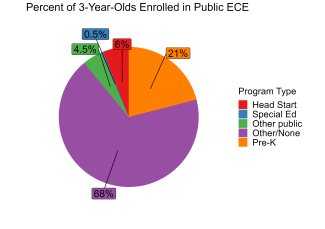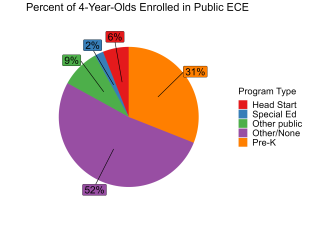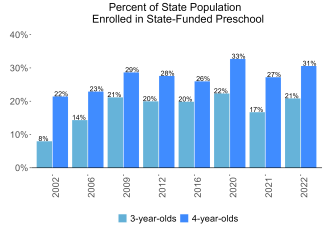
State of Preschool
Illinois
Access Rankings
Resource Rankings
Total Benchmarks Met

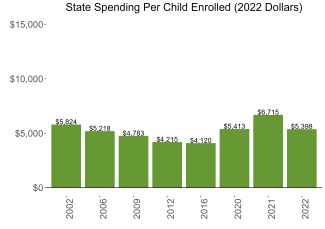
Overview
During the 2021-2022 school year, Illinois preschool enrolled 76,243 children, an increase of 9,634 from the prior year, as the program began to recover from the impact of the COVID-19 pandemic. State spending totaled $411,526,918, down $35,737,811 (8%), adjusted for inflation since last year. State spending per child equaled $5,398 in 2021-2022, down $1,317 from 2020-2021, adjusted for inflation. Illinois met 8 of 10 quality standards benchmarks.
What's New
For FY23, the Governor of Illinois signed the state budget with a 10% increase ($54.4 million) to the Early Childhood Block Grant (ECBG). The funds allowed the Illinois State Board of Education (ISBE) to increase the slots for Preschool for All (PFA), Preschool for All Expansion, and the Prevention Initiative.
In December 2022, Illinois was awarded a federal Preschool Development Grant Birth through Five (PDG B–5) planning grant for $4 million. Funds are planned to be used for an initiative to improve the capacity of community-based early learning providers to identify and serve English learners. The project will provide training for community-based early learning providers to interview families and administer language screeners, as appropriate, and will deploy a team of consultants to conduct screening services on site when needed.
Background
The Illinois Prekindergarten Program for At-Risk Children was founded in 1985. The Illinois PFA initiative began in 2006 with the goal of providing pre-K to all 3- and 4-year-olds by 2012. Starting in 2017, the PFA Expansion Program began when the State was awarded a federal Preschool Development Grant. The Illinois PFA and PFA Expansion programs are now combined to operate in almost all counties; however, enrollment priority continues to be for children who are considered at-risk. This is due to budget constraints preventing the ability to serve all children who might wish to attend. The program is funded through the state ECBG, which also supports the Prevention Initiative for children birth to age three. ECBG funding must be used to serve children aged three or younger, in addition to 4-year-olds.
Funding for Preschool for All is awarded on a competitive basis to public schools, private child care, Head Start, faith-based centers, higher education institutions, and regional offices of education. To be eligible, children must have at least two risk factors, such as low income, history of family neglect, violence, or abuse, exposure to drug or alcohol abuse in the family, developmental delays, low parent education, and homelessness or unstable housing. A second level of priority for Preschool for All enrollment includes families with incomes below 400% of FPL, but there is limited funding available for programs to serve children at this second priority level.
Preschool for All programs are required to provide instruction in children’s home language if there are 20 or more English Language Learners (ELLs) with the same home language enrolled in a program. All pre-K teachers are required to meet bilingual education certification requirements. Language of instruction is determined locally if there are fewer than 20 ELLs with the same home language, however English as a Second Language and other home language supports may be provided.
Illinois Preschool for All and Preschool Expansion
Access
Resources
| Total state pre-K spending | $411,526,918 |
| Local match required? | No |
| State Head Start spending | $0 |
| State spending per child enrolled | $5,398 |
| All reported spending per child enrolled* | $8,081 |
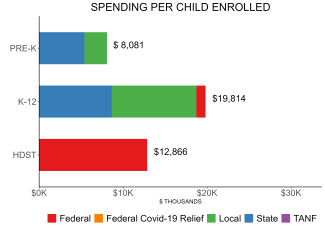
* Pre-K programs may receive additional funds from federal or local sources that are not included in this figure. K–12 expenditures include capital spending as well as current operating expenditures. Head Start per-child spending includes funding only for 3- and 4-year-olds.
Illinois Quality Standards Checklist
| Policy | Requirement | Benchmark | Meets Benchmark? |
|---|---|---|---|
For more information about the benchmarks, see the Executive Summary and the Roadmap to State pages. | 8benchmarks met | ||
| Early Learning & Development Standards Benchmark | Comprehensive, aligned, supported, culturally sensitive | Comprehensive, aligned, supported, culturally sensitive | |
| Curriculum Supports Benchmark | Approval process & supports | Approval process & supports | |
| Teacher Degree Benchmark | BA | BA | |
| Teacher Specialized Training Benchmark | ECE, ECE SpEd | Specializing in pre-K | |
| Assistant Teacher Degree Benchmark | Educator License | CDA or equivalent | |
| Staff Professional Development Benchmark | 120 hours/5 years (teachers); PD plans; Coaching (PFA Expansion) | For teachers & assistants: At least 15 hours/year; individual PD plans; coaching | |
| Maximum Class Size Benchmark | 20 (3- & 4-year-olds) | 20 or lower | |
| Staff to Child Ratio Benchmark | 1:10 (3- & 4-year-olds) | 1:10 or better | |
| Screening & Referral Benchmark | Vision, hearing, health & more | Vision, hearing & health screenings; & referral | |
| Continuous Quality Improvement System Benchmark | Structured classroom observations; Data used for program improvement | Structured classroom observations; data used for program improvement | |
